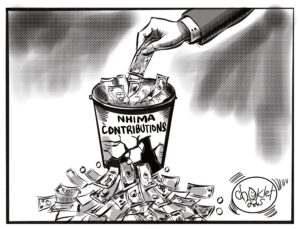In its press release of September 19 2019, the Zambia Electricity Supply Corporation (ZESCO) Limited informed the citizenry that the hours of loading shedding would be adjusted upwardsfrom a minimum of six to eight hours. This adjustment was attributed to the dwindling water levels at Kariba Dam following the serious drought that was experienced during the 2018/2019 rain season. Consequently, according to the press release, the country was now experiencing a staggering 700 megawatt (MW) power deficit, up from 273 MW in June 2019 when the so-called load management began. Three out of the six generating units at the Kariba Dam have been shut to avoid depleting the waterlevels below the critical thresholds. Thus, Kariba Dam is currently only able to generate a daily target of 325 MW against the installed capacity of 1080 MW. Although load shedding by ZESCO has been increased from four hours to six hours, to eight hours on paper, in reality, most households are having to do without power supply for up to twelve or more hours per day in some instances.
I am writing this article to bring to the fore the underlying causes of load shedding which no one at the moment is willing to confront head on. In the midst of the current unprecedented and debilitating load shedding schedule, no one seems prepared to address the difficult questions because it is inconvenient to do so. What if we experience a more severe drought during the 2019/2020 season? What level of load shedding do we anticipate and how are we going to manage it? This is the elephant in the room but no one has courage to confront it. No one is asking the other difficult questions such as the ones I now ask. What is the state of our rivers’ catchments? Are our catchments climate resilient enough to provide us with reasonably acceptable environmental flows even in the midst of a severe drought? If our catchments are currently not climate resilient, what are we doing to make them climate resilient? Ideally, these are the questions around which the current ragging debate on load shedding, which has been casually attributed to climate change,must be anchored on. Of course, literally all the catchments in our country’s major rivers are experiencing serious forest degradation and deforestation which climate change will only worsen. As long as we do nothing or very little to protect and restore our catchments, we cannot entirely rule out a more severe drought in the near future which will result in a more unbearable load shedding schedule and with worse attendant consequences on the economy and livelihoods.
In terms of the much talked about climate change, on the global stage, the Paris Agreement of 2015 was hailed as the greatest breakthrough ever in climate change negotiations for two reasons. Firstly, the near-universal support for it by the 196member states or parties to the United Nations Framework Convention on Climate Change (UNFCCC); and secondly, theextraordinarily quick ratification by the parties which saw the agreement come into force the following year in 2016, four years ahead of schedule. The main objective of the Paris Agreement is to pursue the long term goal of restricting the increase in the global average temperature to less than 2oC, preferably 1.5oC, compared to the pre-industrial levels. The Nationally Determined Contributions (NDCs) submitted by each party, Zambia included, form the main vehicles through which the goal of limiting warming to 2oC would be achieved. The enhanced ambition of limiting warming to 1.5oC hinges on Article 4 (3), of the Paris Agreement which urges parties to commit to higher mitigation targets, which effectively means, no less than at the previous review, at each five-year NDCs review circle. It is this additional commitment to deep cuts of greenhouses gases at every review of the NDCs that could limit the increase in the global average temperature to 1.5oC by the turn of this century.
However, there are signs that all the NDCs submitted by partiesto the UNFCCC secretariat collectively do not come close to achieving the 2oC global goal of the Paris Agreement, let alone 1.5oC by the turn of this century. Several authorities speak to this reality. For example, Rogelj et al. (2016:7609) argue that: “The NDCs collectively lower greenhouse gas emissions compared to where current policies stand, but still imply a median warming of 2.6-3.1oC by 2100”. Additionally, Bastien-Olvera (2019:862) is calling for the total overhaul of the NDCs formulation processes which he considers to be faulty when he notes that “…it is important to ensure that the underlying process of individual NDCs construction is adequate and with the least possible flaws”. To make matters worse, the recently published Special Report by the Intergovernmental Panel on Climate Change (IPCC, 2018) also points to the fact that the NDCs cannot deliver the 2oC global target by the turn of the century. The Special Report indicates that temperature extremes on land are projected to warm more than global mean averages (GMS). Extreme hot days in mid-latitudes could warm by up to about 3°C at global warming of 1.5°C and about 4°C at 2°C. The report further notes that extreme cold nights in high latitudes are projected to warm by up to about 4.5°C at 1.5°C and about 6°C at 2°C. The NDCs fall short of the global 2oC target mainly because parties are reluctant to commit to deep cuts in greenhouse gases due to the attendant implications on economic growth and job creation in their countries. Again, a more severe drought in Zambia cannot be entirely ruled out based on the dynamics presented in the foregoing.
Coming back to the elephant in the room, ZESCO’s ‘greatest innovation’ for powering the nation in the midst of a changing climate, as presented on their website(http://www.zesco.co.zm/projects/generation), is dubbed “Cascaded Generation: An Innovation to Increase Generation Capacity”. Cascaded generation basically is based on the principle that river water is only used for the generation process. The energy from water is used only to run turbines and the water returns back to the river without necessarily losing its quantity or metric volume. For example, the water which is used to generate electricity at the Victoria Falls Power Station, most of which is diverted from the Victoria Falls, will be released back into the Zambezi to be used to generate power at the Batoka Gorge Hydro Electricity Scheme (BHES) (currently under construction). The same water will be further used to generate power at Kariba Dam. This means that in an unfortunate event that the river channel has low water levels as is the case we are facing in Zambia today, all the cascaded power plants on the channel will be negatively affected.
It is shocking and unbelievable that in this day and age, ZESCO’s greatest innovation for power generation is cascaded generation, more so in the midst of a changing climate and currently a unbearable load shedding schedule. Paradoxically, ZESCO has a good number of well-trained environmental scientists who are normally part of the Zambian delegation to the climate change negotiations at the Conference of the Parties (COPs). How cascaded generation still remains the main ‘innovation’ at ZESCO ahead of renewable energy and energy mix in the midst of noticeable climate variability is difficult to comprehend.
Understandably, ZESCO has to defend cascading generation to justify the 2.4 Gigawatt (GW) US$5.2 billion Batoka Gorge Hydro Electricity Scheme (BHES) project which is currently being developed by the Zambezi River Authority (ZRA), and which is jointly owned by the governments of Zambia and Zimbabwe. The African Development Bank (AfDB) Group was named as the lead financier and coordinator of the project in April 2017. The construction of the dam is expected to begin in earnest this year, 2019, while commissioning is expected after 2024. The project is located 54 kilometers downstream of the Victoria Falls, which as I write this article today, can aptly be referred to as the ‘Victoria Falls Rock’ because it is completely dry, partly because large volumes of water are diverted to generate power at the Victoria Falls Hydro Power Plant.
Similarly, the 750 MW US$2 billion Kafue Gorge Lower HydroPower Station is also modeled on the ‘Cascaded Generation Innovation’ concept by ZESCO. The project is funded by the Zambian government and foreign financial institutions such as the Exim Bank of China, and is being constructed by China’s Sinohydro Corporation. The construction began in November 2015 and is scheduled to be completed in 2020. In line with ZESCO’s ‘Cascaded Generation Innovation’ concept, the project is located at about 17.3 km downstream of the existing Kafue Gorge Upper (KGU) Hydro Power Station.
To put the record straight from a scientific perspective, the reason we do not have adequate water in Kariba Dam today for ZESCO to ‘power the nation’ as opposed to ‘plunging it in darkness’ is because we have neglected to protect and restore the catchments of our major rivers. For the Zambezi River Basin, the rate and extent of forest degradation and deforestation that could potentially contribute to enhanced silting and evapotranspiration on the channel hence reduced environmental flows is a major concern. The major drivers of deforestation in the Basin, as identified by the Zambezi River Basin – Atlas of the Changing Environment (2013), include agricultural expansion, fuelwood collection, charcoal burning, commercial harvesting of natural/indigenous timber species and forest fires. These drivers corroborate those identified by the Food and AgricultureOrganisation (FAO) (2013) sponsored study for Zambia entitled Preliminary study on the drivers of deforestation & potential for REDD+ in Zambia. These are some of the issues that ZESCO must be modelling its ‘innovative power projects’ around. These are the issues that the current debate on load shedding in our motherland should be dissecting. The matter is very simple and straight forward, without adequate water in a river channel ZESCO’s ‘Cascaded Generation: An Innovation to Increase Generation Capacity’ mantra will not generate adequateelectricity in the face of climate variability.
To further substantiate the arguments raised in this article, even if the 2.4 GW Batoka Gorge Hydro Electricity Scheme (BHES) was set into operation today, it would NOT provide the envisioned power to ameliorate the devastating effects of the current load shedding schedule. There would simply be no water to generate the power. Perhaps this is the epitome of the fallacy of the cascaded generation approach that ZESCO is promoting as an innovation. The same applies to the Kafue Gorge Lower Hydropower Power Station.
Under a changing climate, ZESCO should be pre- occupied withprotecting and restoring the catchments along the major rivers basins which host the power plants that generate electricity for the nation. ZESCO and the Zambezi River Authority (ZRA)must join hands with the Water Resources Management Authority (WARMA) and the Forestry Department in implementing the Integrated Water Resources Management (IWRM) strategy on our major river catchments. Both ZESCO and ZRA must henceforth apply significant proportions of their annual budgets to supplement the funding of the implementation of the IWRM strategy on our major catchments. The forests on the river catchments are the foundation of the water resource that ZESCO and ZRA depend on to generate power. Therefore, it follows that without healthy forests in the catchments, ZESCO will not be able to generate adequate electricity. The point is, if the catchments are protected and restored where they are degraded, ZESCO would still be able to significantly reduce the load shedding schedule, say to 3 hours, even in the midst of a pronounced drought. But sadly, ZESCO, the Zambezi River Authority and we the citizenry do not seem to be concerned about the health of the catchments. We are only good at lamenting about the long hours of load shedding that we are enduring today.

























4 responses
Thank you very much for this article which which gives me and others an informed position on the future of zambias hydro power generation……take care if our environment and it will take care of us. Climate change is real let the government, NGOs and all organization set up to monitor these water bodies leave their offices and get dirty on the ground, act now not tomorrow, not workshop after workshop without concrete results on the ground.
Very good article. ZESCO LIMITED IS NOW ZAMBIA LIMITED ELECTRICITY SUPPLY CORPORATION
A good article emphasising the urgent need to tackle deforestation and other issues leading to the degradation of water flows. However, no mention of alternative sources of electricity. Development of localised, community based solar panel schemes would lessen provide power to isolated communities without the need for massive infrastructure, and allow other developmental benefits. Why is this option so relatively neglected?
To add these valuable points, a few issues to consider as follows
1. Develop power on the Luapula river which has a better rain pattern
2. Develop water harvesting strategy through development of Dams in strategic places. These would allow us to develop a proper water management strategy by giving us the ability to better control water flows and increase our water storage capacity. Will allow us to capture excess rainfall.
3. Deliberate reforestration – Pine forests and bamboo forest in addition to providing alternative sources of timber and firewood will address the issues raised in the articke above. Bamboo especially is easy to grow and is a completely renewable and drought resistant plant. It matures in 5-6 years and will regenerate adter being cut or burned by fire.
4. Policy – Govt should introduce reverse metering to encourage private small scale generation of power from farms and small house holders. People will be willing to invest in solar and wind systema if they know they can earn some money from their investments. How America and EU gridsbhave encouraged this
5. Efficiency – Zesco can be made more efficient. Disbandle this thing called Zesco. Nigeria has omplemented the studies which were recommended to Zambia. South Africa is following while we still looking at the proposal in our in tray. Private comoanies are more efficient and offer better services. Period.